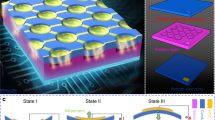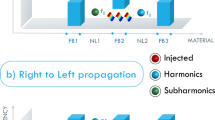Abstract
The detection of acoustic signals is of relevance for a range of practical applications, for example in medical diagnostics. However, whereas rectification of electric current and other energy forms such as thermal flux has been demonstrated1,2,3,4,5,6, acoustic rectification has not yet been achieved. Here, on the basis of the earlier theoretical proposal of an ‘acoustic diode’7, we present the first experimental demonstration of a rectified energy flux of acoustic waves. A one-dimensional acoustic rectifier is fabricated by coupling a superlattice with a layer of ultrasound contrast agent microbubble suspension. A significant rectifying effect is observed within two frequency bands at locations that agree well with theoretical predictions. Following optimization of the concentration of the microbubble suspension, rectifying ratios can be as high as ∼104. This realization of an acoustic rectifier should have substantial practical significance, for example in the focusing of ultrasound in medical applications.
This is a preview of subscription content, access via your institution
Access options
Subscribe to this journal
Receive 12 print issues and online access
$259.00 per year
only $21.58 per issue
Buy this article
- Purchase on Springer Link
- Instant access to full article PDF
Prices may be subject to local taxes which are calculated during checkout





Similar content being viewed by others
References
Li, B. W., Wang, L. & Casati, G. Thermal diode: Rectification of heat flux. Phys. Rev. Lett. 93, 184301 (2004).
Li, B. W., Lan, J. H & Wang, L. Interface thermal resistance between dissimilar anharmonic lattices. Phys. Rev. Lett. 95, 104302 (2005).
Chang, C. W. et al. Solid-state thermal rectifier. Science 314, 1121–1124 (2006).
Kobayashi, W., Teraoka, Y. & Terasaki, I. An oxide thermal rectifier. Appl. Phys. Lett. 95, 171905 (2009).
Li, B. W. & Wang, L. Phononics gets hot. Phys. World 21, 2729 (March 2008).
Nesterenko, V. F. et al. Anomalous wave reflection at the interface of two strongly nonlinear granular media. Phys. Rev. Lett. 95, 158702 (2005).
Liang, B., Yuan, B. & Cheng, J. C. Acoustic diode: Rectification of acoustic energy flux in one-dimensional systems. Phys. Rev. Lett. 103, 104301 (2009).
Monroe, D. One-way mirror for sound waves. Phys. Rev. Focus 24, story 8 (2009).
Liu, Z. Y. et al. Locally resonant sonic materials. Science 289, 1734–1736 (2000).
Ma, J. et al. Acoustic nonlinearity of liquid containing encapsulated microbubbles. J. Acoust. Soc. Am. 116, 186–193 (2004).
Ostrovsky, L. A. Wave processes in media with strong acoustic nonlinearity. J. Acoust. Soc. Am. 90, 3332–3337 (1991).
Ostrovsky, L. A. Nonlinear acoustics of slightly compressible porous media. Sov. Phys. Acoust. 34, 523–526 (1988).
Hamilton, M. F. & Blackstock, D. T. Nonlinear Acoustics 167–174 (Acoustical Society of America, 2008).
Hoff, L. Acoustic Characterization of Contrast Agents for Medical Ultrasound Imaging 43–88 (Kluwer Academic, 2001).
Acknowledgements
This work was financially supported in part by National Basic Research Program 973 of China (Grant No. 2011CB707900), the National Science Foundation of China (Grant Nos. 10804050, 10874086, 10974093, 10704037, 10774072, 11074123 and 10974095), the Ministry of Education of China under Grant No 20060284035 and No 705017 and the Research Fund for the Doctoral Program (for new scholar) of Higher Education of China (20070284070).
Author information
Authors and Affiliations
Contributions
B.L., X.S.G. and J.T. carried out the experiments and interpreted the data. J.C.C. and D.Z. conceived and supervised the study. All of the authors wrote the paper.
Corresponding authors
Ethics declarations
Competing interests
The authors declare no competing financial interests.
Supplementary information
Supplementary Information
Supplementary Information (PDF 420 kb)
Rights and permissions
About this article
Cite this article
Liang, B., Guo, X., Tu, J. et al. An acoustic rectifier. Nature Mater 9, 989–992 (2010). https://doi.org/10.1038/nmat2881
Received:
Accepted:
Published:
Issue Date:
DOI: https://doi.org/10.1038/nmat2881
This article is cited by
-
Observation of non-reciprocal harmonic conversion in real sounds
Communications Physics (2023)
-
Non-reciprocal and non-Newtonian mechanical metamaterials
Nature Communications (2023)
-
A review on additive manufacturing of wave controlling metamaterial
The International Journal of Advanced Manufacturing Technology (2023)
-
Machine learning extreme acoustic non-reciprocity in a linear waveguide with multiple nonlinear asymmetric gates
Nonlinear Dynamics (2023)
-
Direct observation of significant hot carrier cooling suppression in a two-dimensional silicon phononic crystal
NPG Asia Materials (2022)



